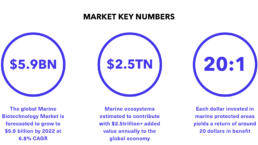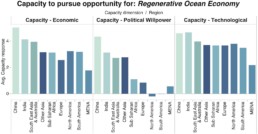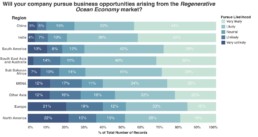The ocean and marine ecosystems provide a wide range of services and resources that directly support human health, societies and economies. Generating ocean ecosystem value creates larger biomasses and more resilience in the environment.
The marine ecosystems have been supporting human societies for millennia. Whether we talk fisheries, aquaculture or simply coastal protection, marine ecosystems have provided services – and continue to – with a measurable value of trillions of dollars. Protecting this source of prosperity is vital for societies worldwide and opens for new opportunities to revolutionize medicine, support food for a world with more people and less arable land and ensures resilient coastal areas to safeguard human settlements against increasing extreme weather and climate change.
Developing ways to use the oceans that supports biodiversity is an opportunity to create resilience and long-term value for society and business. Vital to this is adoption of ambitious goals and corresponding action on a number of macro-problems from global warming to protection of vital areas especially rich in biodiversity or of special importance to the marine wildlife.
Ocean biodiversity has great value in itself and holds promising market potential for the future. Biodiversity supports ecosystem functions, which in turn provide important ecosystem services. Studies estimate that marine ecosystems today contribute with services that can be valued at more than 2.5 trillion USD annually to the global economy. If action is not taken to protect the marine ecosystems, this can be dramatically reduced. Luckily, some human activity in the marine ecosystems can actually be designed in way to constitute a bonus for wildlife. Constructing infrastructures, like offshore wind farms, and bridges, to act as natural reefs or shallows offering sanctuary from fisheries and natural predation and promoting higher biodiversity. A co-benefit here can be more resilient coastal areas to extreme weather occurrences.

New Blue World of Medicine
Investing in protecting the marine ecosystems also promises to open doors for new business cases that involve protecting marine areas, re-building mangroves, and the development of low-impact fishing gear. An entirely new area of opportunity is also opening. Marine biotechnology science was kick-started only five years ago, but it already shows potential for turning the world of medicine upside down. By weight, most of all living organisms found in the ocean are microbial. They may hold the key to the innovative medicines that humanity desperately needs. One marine sponge has been found to have anti-cancer and anti-viral properties. The prospect of finding a new drug in the sea, especially among sponges and coral reef species, is higher than isolating one from a terrestrial ecosystem.
Protecting Habitant Areas
Supporting and protecting marine areas can increase the biodiversity of the ocean and maintain the enormous resource of food, which the ocean currently is. This also includes restoring already destroyed reefs and other marine areas. This will not only create more life in these areas, but also create ecosystem resilience and protect coastal areas from extreme weather.
Studies estimate that the value of the key ocean assets is more than 24 trillion USD; furthermore, that 2/3 of the base economic value of the ocean originates from assets, which depend on healthy ocean conditions. Protecting and regenerating the great biodiversity of the ocean is an investment in the future health of the oceans, of the planet and of humankind. The prosperity of coastal regions is closely related to the marine ecosystem services. Without action to protect the systems that generate this prosperity, societies worldwide will suffer. However, investing in protection of biodiversity will open the doors for new long lasting prosperity
Survey Findings
Regenerative ocean economy is the most popular of the three market opportunities to address the risk of loss of ocean biodiversity surveyed in 2015. However, the three ocean markets are in general not among the highest scorers when compared to all other markets surveyed in 2015.

In South America, this opportunity is perceived to hold great benefits to society but, however, with low capacity to pursue. The greatest capacity to pursue this opportunity as well as the greatest benefits for society is perceived among the respondents in China and India. In North and South America, political will power is perceived to be to be a barrier.
The government sector perceives that it is not likely to be affected and that it is not likely to pursue this opportunity. In the manufacturing sector, we see a paradox as the sector is most likely to pursue the opportunity but it is the least likely to be affected by it. In the eyes of the finance sector it is the least favoured of all opportunities with respect to benefits for society and capacity to pursue. The government and the service sector have also assessed the opportunity to be one that they are less likely to pursue.

Globally both civil society and business are likely to advocate for this opportunity. Especially civil society in South America can be expected to advocate for the realisation of this opportunity. Across different HDI country categories, age and gender there are no relative difference in terms of how they have assessed this opportunity with respect to benefit for society and capacity to pursue.
This market was surveyed globally in 2015 by more than 5500 leaders from both the public and private sectors. The survey was conducted in collaboration with the research company YouGov. The survey results were originally published in the Global Opportunity Report 2016.

